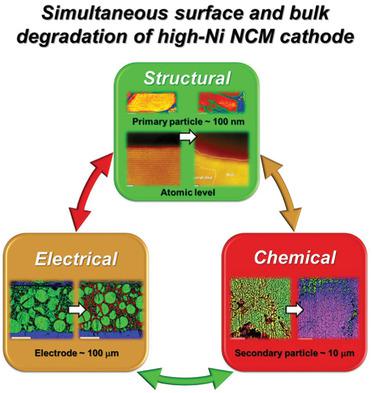当前位置:
X-MOL 学术
›
Adv. Energy Mater.
›
论文详情
Our official English website, www.x-mol.net, welcomes your feedback! (Note: you will need to create a separate account there.)
Degradation of High‐Nickel‐Layered Oxide Cathodes from Surface to Bulk: A Comprehensive Structural, Chemical, and Electrical Analysis
Advanced Energy Materials ( IF 27.8 ) Pub Date : 2020-08-09 , DOI: 10.1002/aenm.202001035 Dong‐Su Ko 1 , Jun‐Ho Park 2 , Byong Yong Yu 3, 4 , Docheon Ahn 5 , Kihong Kim 1 , Heung Nam Han 6 , Woo Sung Jeon 1 , Changhoon Jung 1 , Arumugram Manthiram 4
Advanced Energy Materials ( IF 27.8 ) Pub Date : 2020-08-09 , DOI: 10.1002/aenm.202001035 Dong‐Su Ko 1 , Jun‐Ho Park 2 , Byong Yong Yu 3, 4 , Docheon Ahn 5 , Kihong Kim 1 , Heung Nam Han 6 , Woo Sung Jeon 1 , Changhoon Jung 1 , Arumugram Manthiram 4
Affiliation

|
Multiple applications of lithium‐ion batteries in energy storage systems and electric vehicles require highly stable electrode materials for long‐term battery operation. Among the various cathode materials, high‐Ni cathode materials enable a high energy density. However, cathode degradation accompanied by complex chemical and structural changes results in capacity and voltage fading in batteries. Cathode degradation remains poorly understood; the majority of studies have only explored the oxidation states of transition‐metal ions in localized areas and have rarely evaluated chemical degradation in complete particles after prolonged cycling. This study systematically investigates the degradation of a high‐Ni cathode by comparing the chemical, structural, and electrical changes in pristine and 500 times‐cycled cathodes. Electron probe micro‐analysis and X‐ray energy dispersive spectroscopy reveal changes in the Ni:O ratio from 1:2 to 1:1 over a large area inside the secondary particle. Electron energy loss spectroscopy analysis related to structural changes is performed for the entire primary particle area to visualize the oxidation state of transition‐metal ions in two dimensions. The results imply that the observed monotonic capacity fade without unusual changes is due to the continuous formation of the Ni2+ phase from the surface to the bulk through chemical and structural degradation.
中文翻译:

高镍层氧化物阴极从表面到整体的降解:全面的结构,化学和电学分析
锂离子电池在储能系统和电动汽车中的多种应用需要高度稳定的电极材料,以保证电池长期运行。在各种阴极材料中,高Ni阴极材料可实现高能量密度。然而,伴随复杂的化学和结构变化的阴极退化导致电池的容量和电压衰减。阴极降解仍然知之甚少;大多数研究仅探索局部区域中过渡金属离子的氧化态,并且很少评估长时间循环后完整颗粒中的化学降解。这项研究通过比较原始和500次循环阴极的化学,结构和电学变化,系统地研究了高Ni阴极的降解。电子探针显微分析和X射线能量色散光谱揭示了次级粒子内部大面积区域内Ni:O的比例从1:2变为1:1。对整个一次粒子区域进行与结构变化有关的电子能量损失光谱分析,以二维可视化过渡金属离子的氧化态。结果暗示观察到的单调容量衰减而没有异常变化是由于镍的连续形成通过化学和结构降解从表面到主体的2+相。
更新日期:2020-09-22
中文翻译:

高镍层氧化物阴极从表面到整体的降解:全面的结构,化学和电学分析
锂离子电池在储能系统和电动汽车中的多种应用需要高度稳定的电极材料,以保证电池长期运行。在各种阴极材料中,高Ni阴极材料可实现高能量密度。然而,伴随复杂的化学和结构变化的阴极退化导致电池的容量和电压衰减。阴极降解仍然知之甚少;大多数研究仅探索局部区域中过渡金属离子的氧化态,并且很少评估长时间循环后完整颗粒中的化学降解。这项研究通过比较原始和500次循环阴极的化学,结构和电学变化,系统地研究了高Ni阴极的降解。电子探针显微分析和X射线能量色散光谱揭示了次级粒子内部大面积区域内Ni:O的比例从1:2变为1:1。对整个一次粒子区域进行与结构变化有关的电子能量损失光谱分析,以二维可视化过渡金属离子的氧化态。结果暗示观察到的单调容量衰减而没有异常变化是由于镍的连续形成通过化学和结构降解从表面到主体的2+相。



























 京公网安备 11010802027423号
京公网安备 11010802027423号